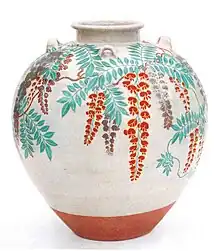Awaji ware
Awaji ware (淡路焼, Awaji-yaki), also known as Minpei or Mimpei ware, is a type of Japanese pottery traditionally made on Awaji Island in the eastern part of the Seto Inland Sea, western Japan.[1][2] Some pieces are porcelain, others described as glazed "porcelaneous ware" or "pottery".

History

Awaji ware was founded in the early 1830s by Minpei Kashu (1796–1871) [3] (last name also spelled Mimpei) from Iga village.[4] Coming from a wealthy trading family, he was a scholar of classical literature and skillful in the art of chanoyu. He became concerned about the development of industrial resources in his province and devoted himself to the manufacture of ceramics, which he had studied under Ogata Shuhei (1788-1839),[5] a famous Kyoto potter.[6] Returning to his village after his studies, he established kilns in the fifth year of Tenpō (1835/1836) and devoted his whole fortune to his enterprises.[7] Some sources give an earlier founding year of 1831.[8] Lord Hachisuka of Awaji Province subsequently subsidized Minpei's manufactory and appointed him head of the workshops. Thus his efforts were successful, and his manufactory reached a prosperity such that its production equaled in value the rice harvest of the eleven surrounding villages.[9] After Minpei's death in the second year of Bunkyū (1862) his successors continued manufacturing ceramics, which became a source of wealth for the province.[10]
The Metropolitan Museum of Art has nine pieces of Minpei ware in its permanent collection.[11]
Characteristics
Awaji ware pieces are of a white or cream-colored clay and a blue or yellow glaze, sometimes also green, sharing similarities with sancai colours. There are pieces skillfully imitating Annan ware's articles and blue and white or blue-decorated porcelains.[9][4]
References
- Chamberlain, Basil Hall (17 July 2014). Things Japanese. Cambridge University Press. ISBN 9781108073851. Retrieved 12 April 2017 – via Google Books.
- "History of Mimpei ware, shopping for Mimpei and its use in Japanese cuisine". savoryjapan.com. Retrieved 12 April 2017.
- "Tea bowl with design of spiny lobster". mfa.org. 18 August 2016. Retrieved 12 April 2017.
- "Introduction to Awaji Pottery". tklibby.com. Retrieved 12 April 2017.
- "Open F-S: Mimpei ware powdered tea caddy (natsume)". si.edu. Archived from the original on 25 March 2017. Retrieved 12 April 2017.
- Gorhan, Hazel H. (2 October 2012). Japanese and Oriental Ceramics. Tuttle Publishing. ISBN 9781462903856. Retrieved 12 April 2017 – via Google Books.
- "Japanese pottery, with notes describing the thoughts and subjects employed in its decoration, and illustrations from examples in the Bowes collection". archive.org. 1890. Retrieved 12 April 2017.
- Gorhan, Hazel H. (2 October 2012). Japanese and Oriental Ceramics. Tuttle Publishing. ISBN 9781462903856. Retrieved 12 April 2017 – via Google Books.
- "Histoire de l'art du Japon;". archive.org. Retrieved 12 April 2017.
- "Histoire de l'art du Japon;". archive.org. Retrieved 12 April 2017.
- "Collection". metmuseum.org. Retrieved 12 April 2017.
Further reading
- Andsley, George and Bowes, James. Ceramic Art of Japan. London: Henry Sotheran and Co., 1881
- Ayers, John. The Bauer Collection of Japanese Ceramics. Boston: Routledge and Kegan Paul Ltd., 1982
- Gorham, Hazel. Japanese and Oriental Ceramics. Rutland, VT and Tokyo; Charles E. Tuttle Co., 1971
- Jenyus, Soame. Japanese Pottery. London: Haber and Faber, 1971
- Morse, Edward. Catalogue of the Morse Collection of Japanese Pottery. Rutland, VT and Tokyo; Charles E. Tuttle Co., 1979
- Noguchi, Sanai. Minpeiyaki. Sumoto; Awajishima Museum, 1989
- Stiff, Irene. Japanese Ceramics of the Last 100 Years. New York; Crown Publishers, Inc., 1971

